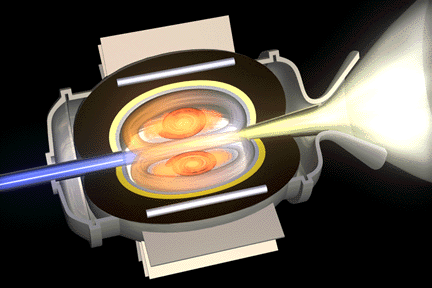
Nuclear Thermal Rockets
Nuclear thermal rockets are rockets that use a form of nuclear reaction to heat up a gas to very high temperatures. Though highly complex, this type of rocket can provide a specific impulse as high as 5000 seconds, which is 11 times the amount of a traditional chemical rocket. Nuclear thermal rockets were originally tested in the 1960ís but was stopped due to public outcry against nuclear programs of every type. The nuclear space age continued on as power plants on deep space missions, the last of which is the Cassini space probe that is on its way to Saturn right now.
There are three types of nuclear reactions to be considered for nuclear thermal rockets: fission, fusion, and antimatter reactions. Fission occurs when heavy elements, such as Uranium, are bombarded by neutrons, causing the elements to split apart. This splitting creates a lot of energy, which is explained by Einsteinís theory of special relativity. This energy is currently harnessed in power plants, but could be used in specially designed space vehicles. The problem with fission is that it produces a lot of radiation in the form of dangerous isotopes, neutrons and high-energy gamma rays (electromagnetic radiation). Though fission would probably never be used for in atmospheric flight, current research is being done into making it safe for manned deep space flight.
Fusion is the binding of very light atoms, such as helium and deuterium (a hydrogen isotope), into heavier atoms. This creates a much larger yield of energy than fission but is much harder to achieve. The atoms must be heated up to very hot temperatures in order to overcome the electromagnetic force of the protons within the atoms. The way to achieve this is to get the atoms to move very fast so that when they collide they stick together, and thus fusion. Current research being done into controllable fusion power has reached the break-even point, which is the point at which power output is equal to power input. Current research being done into materials (which is necessary for the hot temperature plasma (which can reach the temperature at the surface of the sun), magnetic containment, and the use of lasers to create fusion promise to make this technology feasible within the decade. For use as an alternative for space propulsion, it will probably take half a century or more before any feasible system is developed, as the optimum fuel for fusion, Helium Ė3, an isotope, is not available on Earth, but available in large quantities on the Moon.
Antimatter is currently being researched by the MSFC as another means of interplanetary travel. Antimatter is the twin of matter. It has the same mass of its counterpart, but opposite charge and spin (which is a property of subatomic particles). Every particle has an antimatter counterpart, the opposite of a proton is a positron, the opposite of a neutron is the antineutron. Luckily, when the universe was created, nature singled out matter as the means by which the universe would exist. The reason for this luck is the way matter and antimatter interacts. When these two types of particles touch, a series of subatomic reactions cause all of the rest mass of the object to turn into energy, therefore annihilating each other. This also means that antimatter/matter reactions have the highest energy yield of any nuclear reactions. 42 milligrams of antiprotons has the energy content equal to that of 750,000 kilograms of fuel and oxidizer in the Space Shuttle main tank. And would have specific impulses as high as 10,000 seconds.
Currently not much antimatter has been created, though, as of recently, advances have been made that yield antimatter atoms (antiproton and electron), for more than a few nanoseconds. NASA believes that within four decades a method to create and store viable amounts of antimatter will be created.
Three types of reactors could be used for fission reactions: solid, liquid, and plasma cores. The solid core was demonstrated in the 1960ís. This involves a scaled down version of power plants with graphite control rods. A central channel runs through the center of the plant. The reactor, once properly shielded, directs its energy to the central channel. An inert gas is passed through the center of the core so that it can be heated up to a very high temperature and expelled at very high speeds. The liquid and plasma core operate in the same manner, but in different states. In both of these engines, the graphite rods have been removed so that the heavy atoms can reach the given state. In the case of the plasma core, more material is added so that a gaseous state can be reached. But the gas that is to be used as the exhaust cannot pass though these very easily. Therefore, a torroidal chamber, which has the shape of a doughnut, but elongated in the direction of the hole is used as the holding chamber. The inner part of the toroid is the nozzle for the inert gas. A suitable mterial will have to be developed if this were ever to be realized, as the operating temperature of the liquid or plasma core is extremely high. The inert gas is then shot through this hole, and as before is heated up and then exhausted though a nozzle. Figure 10 shows an artists concept of what this reactor would look like.

Figure 10
Other Related Sites: